Abstract
This paper considers the problem of empirically analyzing the linear congruential generators (LCGs) with ten largest prime moduli smaller than 231. For each modulus, a computer exhaustive search is conducted to find the 20 good multipliers with respect to spectral value for the full period LCGs. Eleven two-level statistical tests are applied to evaluate and compare the local randomness behaviors of these good LCGs. It is shown that modulus does not significantly affect spectral value. The spectral value and the two-level statistical test are also uncorrelated.
Similar content being viewed by others
References
J.W.S. Cassels (1959) An Introduction to the Geometry of Number Springer-Verlag New York
R.R. Coveyou D. MacPherson R (1967) ArticleTitleFourier analysis of uniform random number generators Journal of the ACM 14 100–119 Occurrence Handle10.1145/321371.321379
U. Fincke M. Pohst (1985) ArticleTitleImproved methods for calculating vectors of short length in a lattice, including a complexity analysis Mathematics of Computation 44 463–471
G.S. Fishman (1990) ArticleTitleMultiplicative congruential random number generators with modulus 2β: an exhaustive analysis for β=32 and a partial analysis for β=48 Mathematics of Computation 54 331–344
G.S. Fishman (1996) Monte Carlo: Concepts, algorithms, and applications. Springer Series in Operations Research Springer-Verlag New York
G.S. Fishman L.R. Moore SuffixIII (1986) ArticleTitleAn exhaustive analysis of multiplicative congruential random number generators with modulus 231 − 1 SIAM Journal on Scientific and Statistical Computing 7 24–45 Occurrence Handle10.1137/0907002
A. Grube (1973) ArticleTitleMehrfach rekursiverzeugte pseudo-zufallszahlen Zeitschrift für angewandte Math. Und Mechank 53 T223–T225
D.E. Knuth (1997) The Art of Computer Programming Vol 2: Semi-numerical Algorithms EditionNumber3 Addison-Wesley Reading, MA
L’Ecuyer P. (1992). Testing random number generators. Proceeding of the 1992 Winter Simulation Conference 305–313
P. L’Ecuyer (1999) ArticleTitleTables of linear congruential generators of different sizes and good lattice structure Mathematics of Computation 68 249–260 Occurrence Handle10.1090/S0025-5718-99-00996-5
D.H. Lehmer (1951) Proceedings 2nd Symposium on Large-scale Digital Calculating Machinery Harvard University Press Cambridge 141–146
Marsaglia G. Zaman A. (1993) ArticleTitleMonkey tests for random number generators Computers and Mathematics with Applications 26 1–10 Occurrence Handle10.1016/0898-1221(93)90001-C Occurrence HandleMR1236767
Niederreiter, H. (1992). Random Number Generation and Quasi-Monte Carlo Methods. SIAM CBMS-NSF Regional Conference Series in Applied Mathematics, 63, SIAM, Philadelphia
SAS Institute Inc. (1991). SAS Procedures Guide. Release 6.03 Edition. Cary, NC, USA
A. Sáanchez-Bruno C.S. Luis-Costas (1995) ArticleTitleA statistical analysis of seven multiples for linear congruential random number generators with modulus 231 − 1 Quality & Quantity 29 331–337
H.C. Tang (2000) ArticleTitleImplementing a multiple recursive generator with Mersenne prime modulus International Journal of Computer Mathematics 76 35–43
H.C. Tang (2001) ArticleTitleA statistical analysis of the screening measure of multiple recursive random number generators of orders one and two Journal of Statistical Computation and Simulation 71 345–356 Occurrence HandleMR1888830
H.C. Tang (2002a) ArticleTitleCombined random number generator via the generalized Chinese remainder theorem Journal of Computational and Applied Mathematics 142 377–388 Occurrence Handle10.1016/S0377-0427(01)00424-1
H.C. Tang (2002b) ArticleTitleModified decomposition method for multiple recursive random number generator Mathematics and Computers in Simulation 59 451–456 Occurrence Handle10.1016/S0378-4754(01)00428-1
H.C. Tang C. Kao (2002) ArticleTitleLower bounds in spectral tests for vectors of nonsuccessive values produced by multiple recursive generator with some zero multipliers Computers & Mathematics with Applications 43 1153–1159
Author information
Authors and Affiliations
Corresponding author
Rights and permissions
About this article
Cite this article
Tang, HC. Modulus of Linear Congruential Random Number Generator. Qual Quant 39, 413–422 (2005). https://doi.org/10.1007/s11135-004-6788-6
Issue Date:
DOI: https://doi.org/10.1007/s11135-004-6788-6




